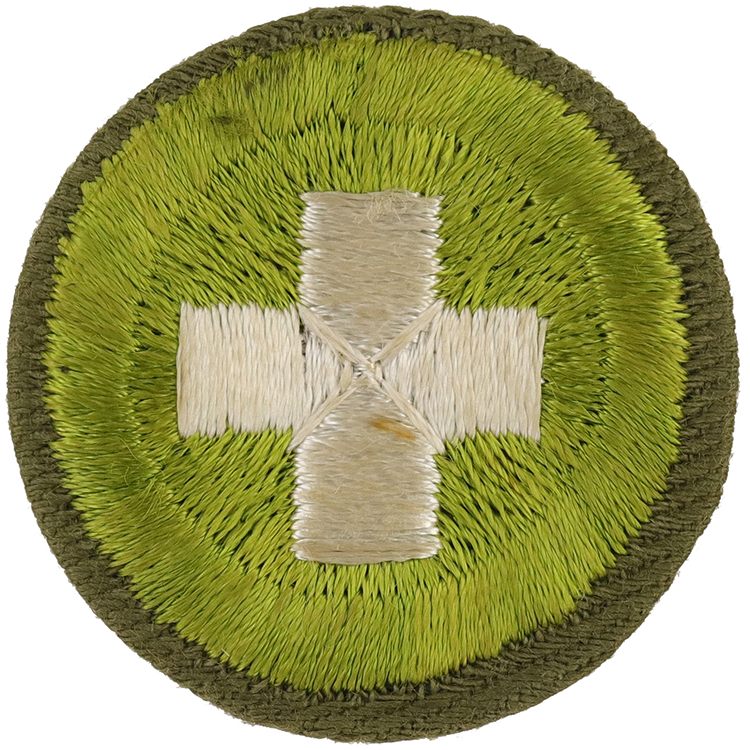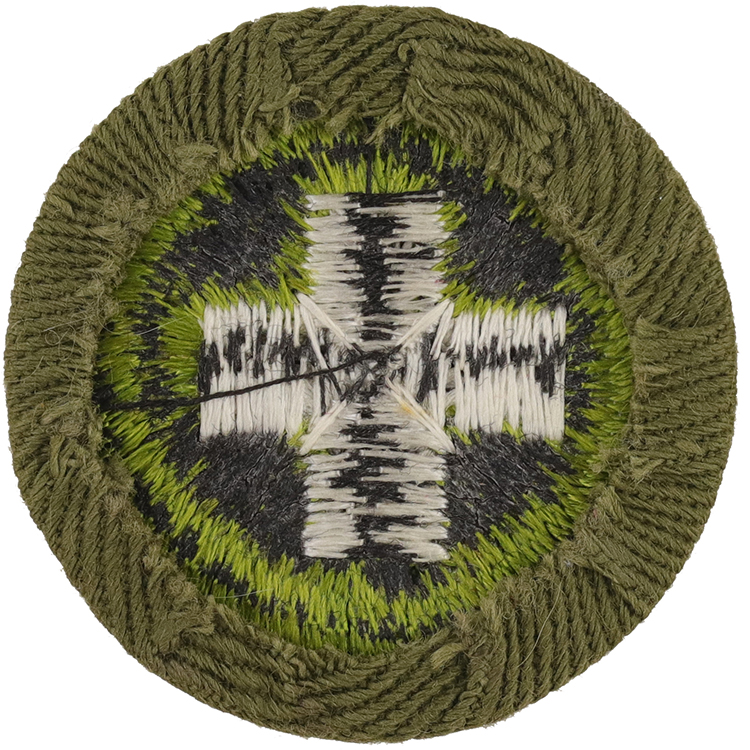
Fig. 1: Safety-E2-Front
- Cloth: Khaki right twill
- Embroidery: Cotton lock stitch

Fig. 2: Safety-E2-Reverse
- Back: Plain NO imprint with starch

Fig. 3: Safety-E2-mve1-front
- Cloth: Khaki right twill
- Embroidery: Cotton continuous

Fig. 4: Safety-E2-mve1-reverse
- Minor variation: Black lock stitch, plain NO imprint with starch
Item Name: Safety 1947 - 1960
Item ID: Safety-E2
Collector Rating: 1
Requirements November 1932 until June 1952
1. Submit evidence of having satisfactorily done one of the following:
(a) Made a safety inspection of his home and premises, listed conditions which might prove dangerous, and taken practical measures to remedy at least two such conditions; or
(b) Actively shared in the safety work in school over a period of at least ten weeks and at all times done his best by example and attitude to interest his schoolmates in safety activities; or
(c) Built cabinet for the safe and proper storage of medicines and poisons; or kitchen cabinet for storage of lye, "lysol", ammonia, etc.; or suitable play pen for the baby, screening, if desired, for outdoor use; or gate guarding stairs for children; or safety rail for cellar stairs with painted white stripes on lowest step; or built and filled sandbox for slipper walks; or recommended a needed safety device for home or Troop and when approved by Counselor, made such device.
2. Demonstrate how he would make himself visible while walking on the road at night; explain on which side of the road he should walk, day or night, and why.
3. Demonstrate with a modern gun:
(a) The direction in which he should point the muzzle when picking it up and tell why;*
(b) Other safety precautions which should always be taken to avoid accident when handling a gun or passing it to another person, and tell why.*
4. Demonstrate, with a full size axe, the correct way to carry it safely;
(b) Demonstrate how to handle, carry, and store safely different kinds of farm tools such as scythe, sickle and pitch fork, or sharp edged tools about the home or shop.
5. Demonstrate (a) with another boy what action he would take, and tell why, in the following situation:
Some children have been playing with fire; the clothing of one becomes ignited;
(b) With two other boys, method he would use, (1) with a 20-foot rope, and (2) with a board, to rescue a fourth boy who had broken through the ice;
(c) How he would save himself if he had broken through the ice, and there were no help in sight.
6. Submit and comment on newspaper account which he has gathered within a period of the past six months describing at least three different kinds of accidents due to any of the following causes: (a) Stealing rides on automobiles or street cars; (b) Hitch hiking; (c) Crossing street or highway; (d) Reckless driving; (e) Failure to observe a traffic law.
7. Explain, in discussion with his Counselor, or dramatize with members of his Patrol, what he considers the main safety hazards involved in modern transportation, industry, recreation, and in the home, indicating general ways in which they should be met, including also ways for dealing with such specific problems as:
(a) Escaping gas; (b) wire dangling from electric line; (c) safe storage and use of gasoline; (d) running engine in closed garage; (e) three ways of turning in fire alarm, citing best local method and giving exact location of nearest fire alarm to his home or place of employment; (f) appearance of blasting caps, their use, and precautions against untimely explosion.
* Note--This Requirement must be waives when it involves conflict with local or state law relating to ownership and use of firearms. In all other cases evidence must be produced that all practice and the test have been conducted under a range officer whose appointment has been approved by the Local or National Council. (This Requirement does not necessitate Scout's supplying gun).
Requirements June 1952 until September 1958
1. Submit evidence of having satisfactorily done one of the following: (a) made a safety inspection of your home and premises, listed conditions which might prove dangerous and taken practical measures to remedy at least two such conditions--or (b) actively shared in the safety work in school over a period of at least ten weeks and at all times done your best by example and attitude to interest your schoolmates in safety activities--or (c) built cabinet for the safe and proper storage of medicines and poisons; or kitchen cabinet for storage of lye, Lysol, ammonia, etc., or suitable playpen for the baby, screening, if desired, for outdoor use; or gate guarding stairs for children; or safety rail for cellar stairs with painted white stripes on lowest step; or built and filled sandbox for slippery walks; or recommended a needed safety device for home or troop and, when approved by counselor, made such device.
2. Demonstrate how you would make yourself visible while walking on the road at night; explain on which side of the road you should walk, day or night, and why.
3. Demonstrate with a modern gun: (a) direction in which you should point the muzzle when picking it up and why;* (b) other safety precautions which should always be taken to avoid accident when handling a gun or passing it to another person and tell why.*
4. (a) Demonstrate, with a full-size axe, the correct way to carry it safely. (b) Demonstrate how to handle, carry, and store safely different kinds of farm tools such as scythe, sickle, and pitch fork, or sharp-edged tools about the home or shop.
5. Demonstrate (a) with another boy, what action you would take, and tell why, in the following situation: Some children have been playing with fire; the clothing of one becomes ignited; (b) with two other boys, method you would use, with a 20-foot rope, and with a board, to rescue a fourth boy who had broken through the ice; (c) how you would save yourself if you had broken through the ice and there were no help in sight.
6. Submit and comment on twenty-five newspaper accounts which you have gathered within a period of the past six months describing at least three different kinds of accidents due to any of the following causes: (a) stealing rides on automobiles or streetcars; (b) hitchhiking; (c) crossing street or highways; (d) reckless driving; (e) failure to observe a traffic law.
7. Explain, in discussion with your counselor, or dramatize with members of your patrol, what you consider the main safety hazards involved in modern transportation, industry, recreation, and in the home, indicating general ways in which they should be met, including also ways for dealing with such specific problems as: (a) escaping gas; (b) wire dangling from electric line; (c) safe storage and use of gasoline; (d) running engine in closed garage; (e) three ways of turning in fire alarm, citing best local method and giving exact location of nearest fire alarm to your home or place of employment; (f) appearance of blasting caps, their use, and precautions against untimely explosion.
* NOTE: This requirement must be waived when it involves conflict with local or state law relating to ownership and use of firearms. In all other cases evidence must be produced that all practice and the test have been conducted under a range officer whose appointment has been approved by the local or National Council. (This requirement does not necessitate Scout's supplying gun.)
Requirements September 1958 until September 1963
1. Write a report of not less than 150 words on one of the following topics or come prepared with notes to discuss them with your merit badge counselor: (a) Accident figures in the U.S. for one year. Include number of deaths and injuries in the four principal accident classes (work, motor vehicle, home, public) and costs of accidents. Explain how a serious accident to you or your parents can change your life. (b) Unsafe actions and accidents. Explain how at least five unsafe actions can cause death or injury. (c) Safety and daily living. Explain how safety information acquired in Scouting can help you in daily living. Also tell how safety helps you enjoy adventures.
2. Watch drivers and pedestrians at or near an intersection for a total of three hours (can be done half hour, one hour, etc., at a time). List the unsafe practices you see and explain what would have been the safe practice in each case.
3. Demonstrate or list five important safety practices for each of the following: Walking, bicycle riding, automobile driving in town, automobile driving in the country.
4. Do one: (a) Assist in an organized safety campaign. (b) Visit and report on a local traffic court. (c) Add reflective material to farm equipment used on the highway.
5. Using a safety check list, complete a safety inspection of your home and premises. Explain what hazards have been corrected and how.
6. Describe safety practices in the home that help prevent falls, burns and scalds, and poisonings.
7. Explain to your counselor safety precautions related to the following: Dogs or other pets, firearms, hiking and camping, hand tools, electric wires, blasting caps, outdoor fires, swimming, excavations, winter sports or summer sports (except swimming).
8. List safety precautions that should be followed in two work areas where boys of Scout age might be employed, either in after-school or vacation jobs.
9. Do one: (a) Report on a safety project in which you participated at school, at church, or in the community. (b) Get permission and accompany a building or fire inspector on a safety inspection tour of a public building. Make a report of the tour. (c) Get permission and accompany a safety director, safety engineer, or safety inspector of an industrial plant on a safety inspection tour of his plant. Make a report of the tour.
10. Discuss with your counselor how you can contribute to the safety of yourself, your family, and your community.
-------
NOTE: This requirement must be waived when it involves conflict with local or state law relating to ownership and use of firearms. In all other cases evidence must be produced that all practice and the test have been conducted under a range officer whose appointment has been approved by the local or National Council. (This requirement does not necessitate Scout's supplying gun.)






